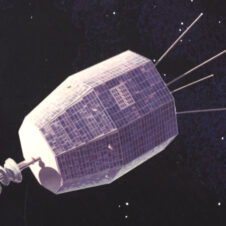An international team led by astronomers from the Curtin University node of the International Centre for Radio Astronomy Research (ICRAR) has discovered a new type of stellar object that challenges our understanding of the physics of neutron stars.
The object could be an ultra-long period magnetar, a rare type of star with extremely strong magnetic fields that can produce powerful bursts of energy.
An animation describing the discovery, the behaviour of the object and what it might look like. Credit: ICRAR.
Until recently, all known magnetars released energy at intervals ranging from a few seconds to a few minutes. The newly discovered object emits radio waves every 22 minutes, making it the longest period magnetar ever detected.
The research was published today in the journal Nature.
Astronomers discovered the object using the Murchison Widefield Array (MWA), a radio telescope on Wajarri Yamaji Country in outback Western Australia.

Dr Natasha Hurley-Walker on-site at CSIRO’s Murchison Radio-astronomy Observatory, amongst the core ’tiles’ of the Murchison Widefiled Array.
Lead author Dr Natasha Hurley-Walker said the magnetar, named GPM J1839−10, is 15,000 light-years away from Earth in the Scutum constellation.
“This remarkable object challenges our understanding of neutron stars and magnetars, which are some of the most exotic and extreme objects in the Universe,” she said.
The stellar object is only the second of its kind ever detected after the first was discovered by Curtin University undergraduate research student Tyrone O’Doherty.
Initially, scientists could not explain what they had found.
They published a paper in Nature in January 2022 describing an enigmatic transient object that would intermittently appear and disappear, emitting powerful beams of energy three times per hour.
Dr Hurley-Walker—O’Doherty’s honours supervisor—said the first object took us by surprise.
“We were stumped,” she said. “So we started searching for similar objects to find out if it was an isolated event or just the tip of the iceberg.”
Between July and September 2022, the team scanned the skies using the MWA telescope.
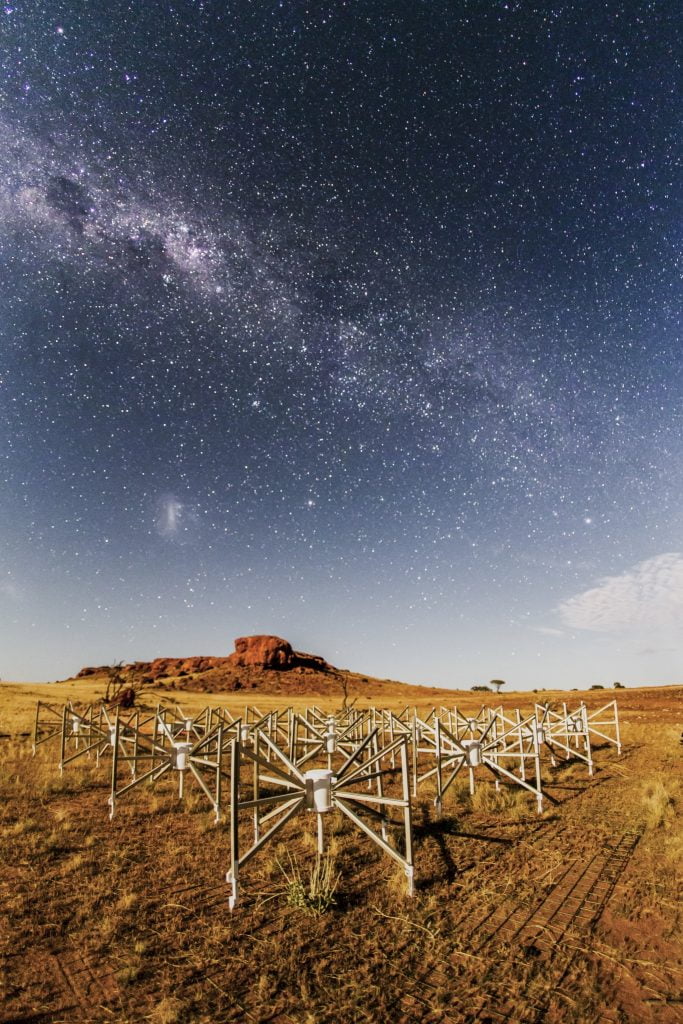
One of 256 tiles of the Murchison Widefield Array (MWA). The MWA is a precursor instrument to the Square Kilometre Array radio telescopes. Photographed by Pete Wheeler.
They soon found what they were looking for in GPM J1839−10.
It emits bursts of energy that last up to five minutes—five times longer than the first object.
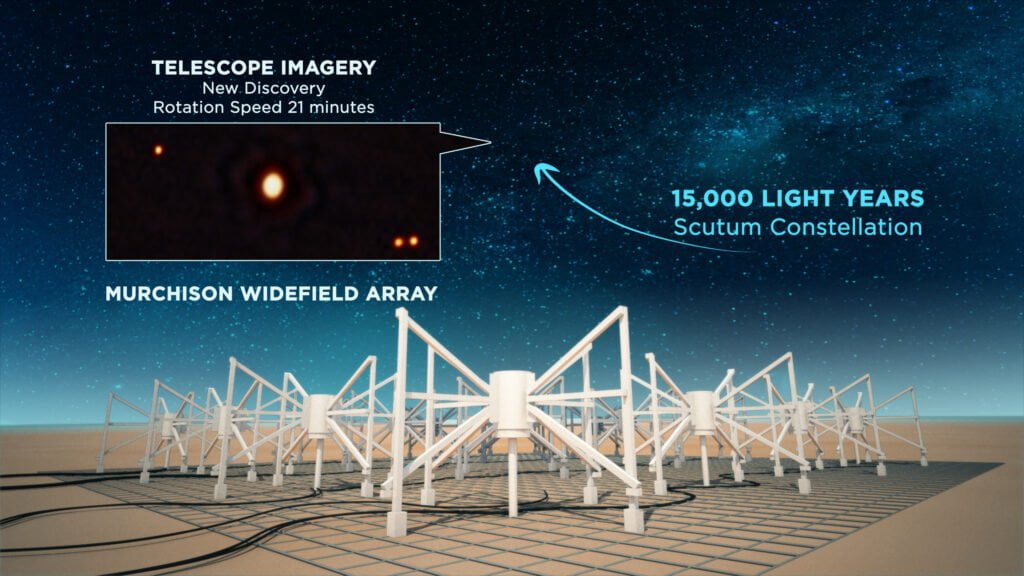
An artist’s impression of the Murchison Widefield Array radio telescope observing the ultra-long period magnetar, 15,000 light-years away from Earth in the Scutum Constellation. Credit: ICRAR
Other telescopes followed up to confirm the discovery and learn more about the object’s unique characteristics.
These included three CSIRO radio telescopes in Australia, the MeerKAT radio telescope in South Africa, and the XMM-Newton space telescope.
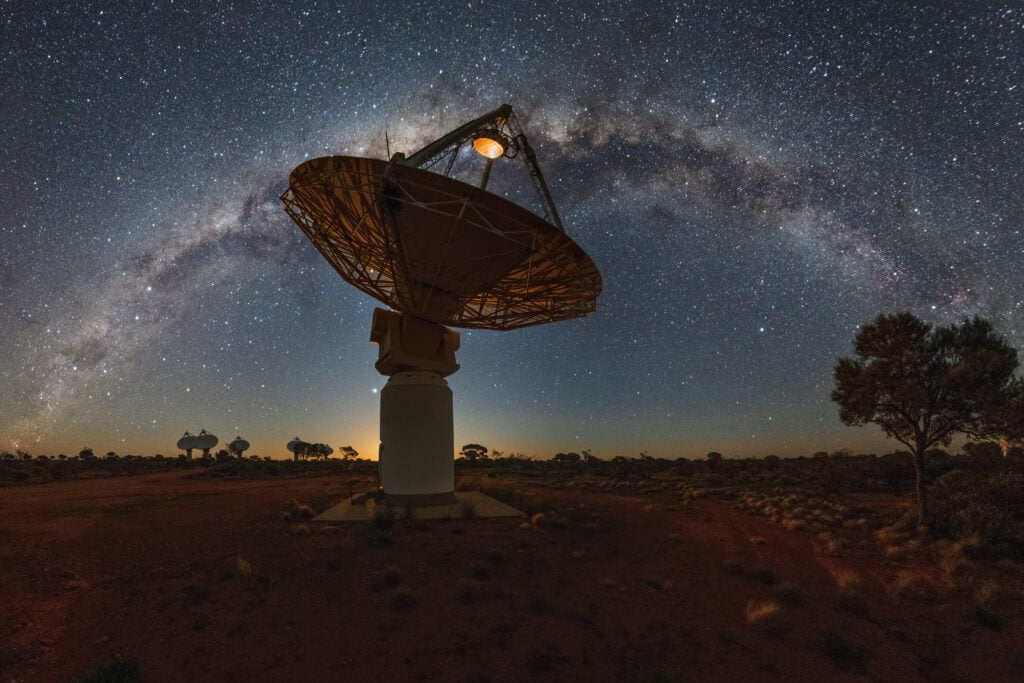
CSIRO’s ASKAP radio telescope on Wajarri Yamaji Country. Like the MWA, ASKAP is a precursor instrument to the Square Kilometre Array telescopes. Credit: Alex Cherney
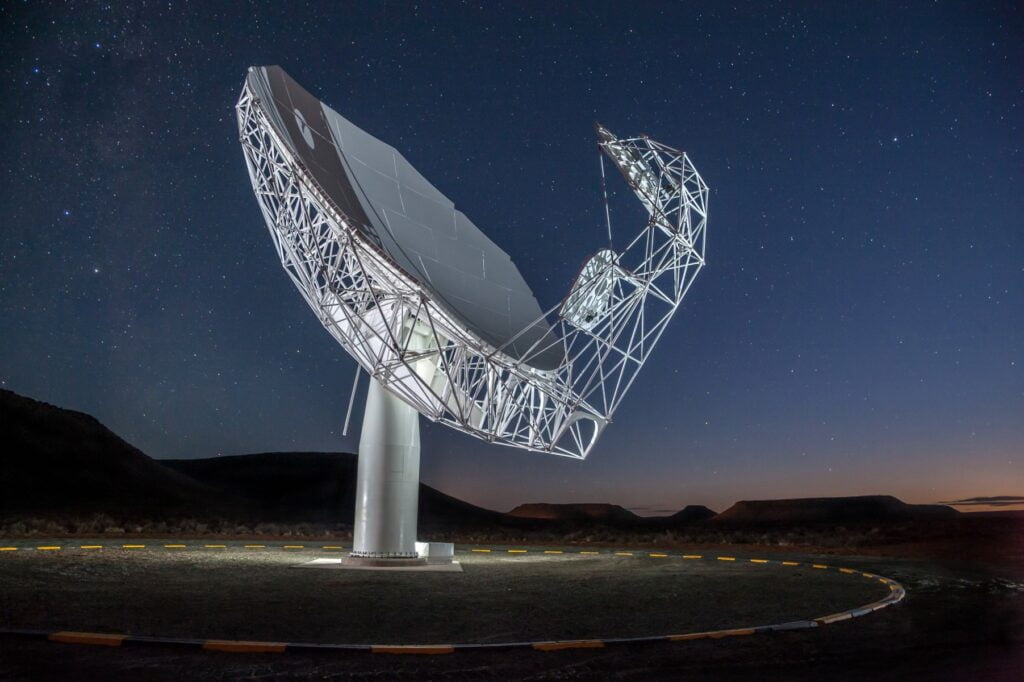
MeerKAT is a radio telescope consisting of 64 antennas in the Northern Cape region of South Africa. Like the MWA and ASKAP, MeerKAT is a precursor to the Square Kilometre Array telescopes. Credit: Morganoshell
Armed with GPM J1839−10’s celestial coordinates and characteristics, the team also began searching the observational archives of the world’s premier radio telescopes.
“It showed up in observations by the Giant Metrewave Radio Telescope (GMRT) in India, and the Very Large Array (VLA) in the USA had observations dating as far back as 1988,” she said.
“That was quite an incredible moment for me. I was five years old when our telescopes first recorded pulses from this object, but no one noticed it, and it stayed hidden in the data for 33 years.
“They missed it because they hadn’t expected to find anything like it.”
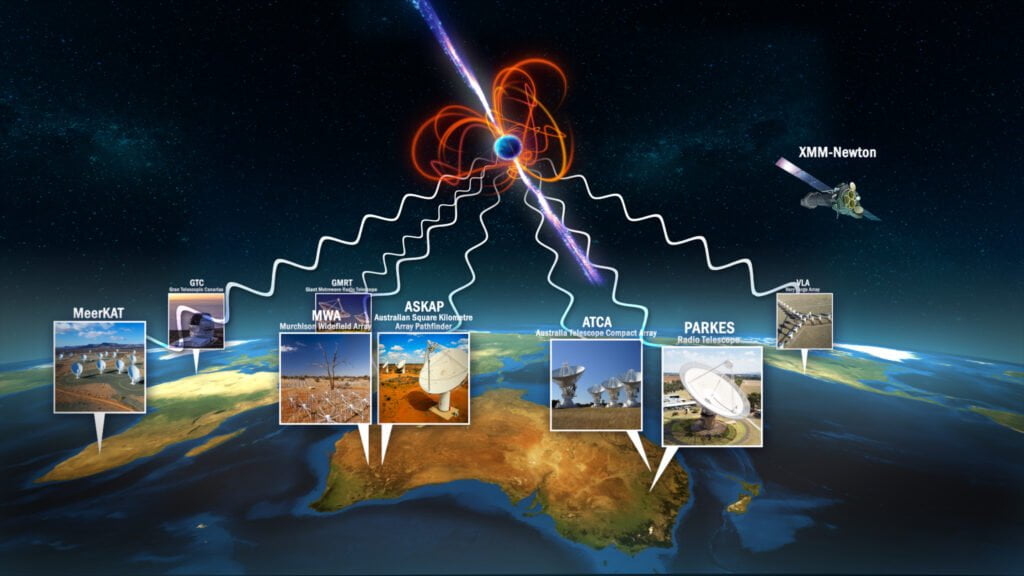
The magnetar was discovered by the Murchison Widefield Array (MWA) radio telescope, with a host of other facilities around the globe joining in to confirm the discovery and study the object.
MeerKAT—Credit: South African Radio Astronomy Observatory (SARAO), Gran Telescopio Canarias—Credit: Daniel López/IAC, Murchison Widefield Array—Credit: Marianne Annereau, Giant Metrewave Radio Telescope—Credit: NCRA, Australian SKA Pathfinder—Credit: CSIRO/Dragonfly Media, Australia Telescope Compact Array—Credit: CSIRO, Parkes Radio Telescope, Murriyang—Credit: CSIRO, Very Large Array—Credit: AUI/NRAO, XMM-Newton—Credit: European Space Agency
Not all magnetars produce radio waves. Some exist below the ‘death line’, a critical threshold where a star’s magnetic field becomes too weak to generate high-energy emissions.
“The object we’ve discovered is spinning way too slowly to produce radio waves—it’s below the death line,” Dr Hurley-Walker said.
“Assuming it’s a magnetar, it shouldn’t be possible for this object to produce radio waves. But we’re seeing them.
“And we’re not just talking about a little blip of radio emission.
“Every 22 minutes, it emits a five-minute pulse of radio wavelength energy, and it’s been doing that for at least 33 years.
“Whatever mechanism is behind this is extraordinary.”
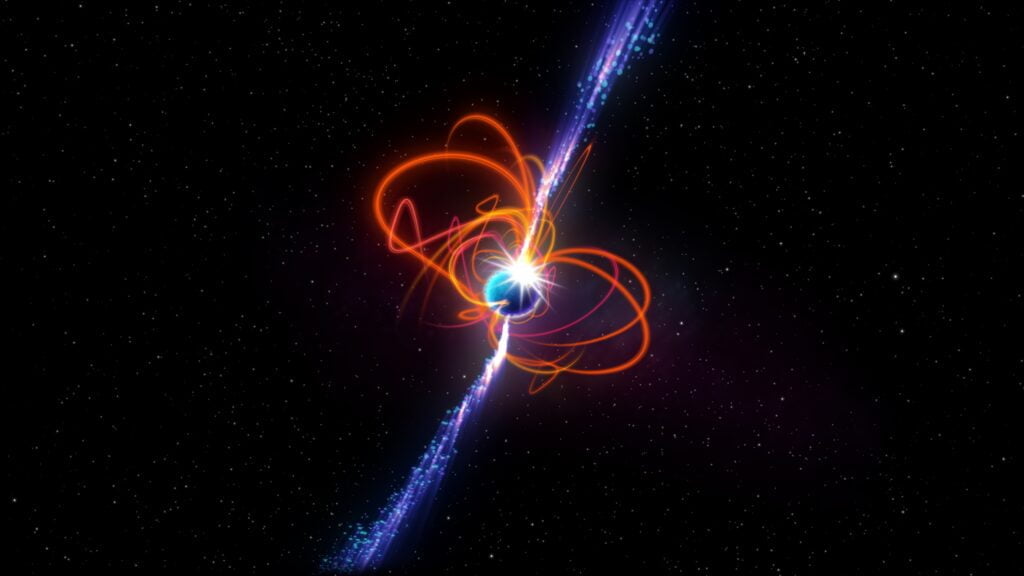
An artist’s impression of the ultra-long period magnetar—a rare type of star with extremely strong magnetic fields that can produce powerful bursts of energy. Credit: ICRAR.
The discovery has important implications for our understanding of the physics of neutron stars and the behaviour of magnetic fields in extreme environments.
It also raises new questions about the formation and evolution of magnetars and could shed light on the origin of mysterious phenomena such as fast radio bursts.
The research team plans to conduct further observations of the magnetar to learn more about its properties and behaviour.
They also hope to discover more of these enigmatic objects in the future, to determine whether they are indeed ultra-long period magnetars, or something even more phenomenal.
The MWA is a precursor to the world’s largest radio astronomy observatory, the Square Kilometre Array, which is under construction in Australia and South Africa. The MWA celebrates a significant milestone this year as it completes a decade of operations and international scientific discovery.

Composite image of the SKA-Low telescope in Western Australia. The image blends a real photo (on the left) of the SKA-Low prototype station already on-site with an artist’s impression of the future SKA-Low stations as they will look when constructed. These dipole antennas, which will number in the hundreds of thousands, will survey the radio sky at frequencies as low as 50Mhz. Credit: ICRAR, SKAO.
We acknowledge the Wajarri Yamaji as the Traditional Owners and native title holders of Inyarrimanha Ilgari Bundara, the CSIRO Murchison Radio-astronomy Observatory site where the Murchison Widefield Array is located.
The Pawsey Supercomputing Research Centre in Perth–a Tier 1 publicly funded national supercomputing facility–helped store and process the MWA observations used in this research.
Publication
‘A long-period radio transient active for three decades’, published in Nature on July 20, 2023.
Supporting Multimedia
You are welcome to use any of the images and videos shown on this webpage in press articles or on social media, with the credit line intact.
More Information
ICRAR
The International Centre for Radio Astronomy Research (ICRAR) is a joint venture between Curtin University and The University of Western Australia with support and funding from the State Government of Western Australia.
Telescopes & Observatories
CSIRO, Australia’s national science agency, owns and operates the Australia Telescope National Facility (ATNF), which includes the Parkes 64-metre radio telescope, Murriyang and the Australia Telescope Compact Array in New South Wales, and the ASKAP radio telescope in Western Australia.
Along with MeerKAT in South Africa, the ATNF instruments were involved in following up the initial observations made by the MWA.
A faint source, which aligns with the position of GPMJ 1839−10, was detected at infrared wavelengths using a spectrograph mounted on the Gran Telescopio Canarias. Referred to as ‘GranTeCan’ or ‘GTC,’ this telescope holds the distinction of being the world’s largest single-aperture optical telescope. It is situated on the island of La Palma, in the Canaries, Spain.
An observation with XMM-Newton X-ray space telescope simultaneous to the ASKAP observation did not detect any X-ray emission from the position of GPMJ 1839−10.
Searches of archival data involved the Very Large Array (VLA), the VLA Low-band Ionospheric and Transient Experiment (VLITE), and the Giant Metrewave Radio Telescope (GMRT).
The Square Kilometre Array
The MWA, ASKAP and MeerKAT are all precursors to the international Square Kilometre Array (SKA) project. Construction of the two SKA telescopes has started and is expected to finish by 2028.
Australia will host SKA-Low at Inyarrimanha Ilgari Bundara, the CSIRO Murchison Radio-astronomy Observatory, which will have 131,072 antennas receiving low-frequency radio waves. Each antenna will be 2 metres tall and shaped like a Christmas tree.
South Africa will host SKA-Mid, which will be made up of 197 dish antennas receiving mid-frequency radio waves.
Interviews
Dr Natasha Hurley-Walker | ICRAR / Curtin University
Natasha.Hurley-Walker@curtin.edu.au
Professor Steven Tingay | ICRAR / Curtin University
S.Tingay@curtin.edu.au
MEDIA Enquiries
Charlene D’Monte | ICRAR
charlene.dmonte@icrar.org | +61 468 579 311
Lucien Wilkinson | Curtin University
lucien.wilkinson@curtin.edu.au | +61 401 103 683 | +61 8 9266 9185

